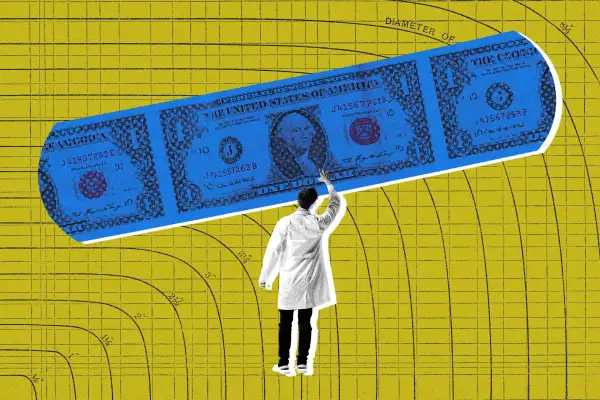Medical Debt vs. Student Loan Debt: Which Would You Cancel?

Americans would rather see the federal government forgive medical debt over student loan debt.
A small majority, 51%, of Americans say it’s “extremely” or “very important” for the government to broadly forgive medical debt, while 39% say the same for student loans according to a recent survey from AP-NORC, a partnership between the University of Chicago and the Associated Press.
The researchers found that respondents' own experience with debt — especially student loans — tends to influence their views, writing “those who are currently paying student loans are more likely than respondents who have paid off loans or have no experience with student debt to consider student debt relief from the federal government important.”
Political affiliation was also a major factor, with Democrats more likely to back federal debt cancellation efforts than independents and Republicans.
Medical debt vs. student loan debt
Despite student loan debt being a far more prevalent issue in terms of debt owed and the number of people affected, Americans are more likely to support canceling medical debt.
According to the latest figures from the Federal Reserve, over 40 million Americans hold $1.7 trillion of student debt, including both federal and private student loans.
On the other hand, the nonprofit Kaiser Family Foundation estimates that about 20 million Americans owe a total of at least $220 billion in medical debt. That number is a conservative estimate, as KFF notes, because tracking medical debt can be difficult.
For instance, it's common practice for folks struggling to pay their medical bills to put a payment on their credit card. At that point, the debt is no longer considered medical debt but credit card debt.
Even so, the true amount of medical debt is likely much lower than student loan debt, yet most Americans would support federal government initiatives to wipe it away.
One major reason why could be the very nature of medical debt. Often, “the debt is taken on unexpectedly and in a time of crisis,” Rohit Chopra, director of the Consumer Financial Protection Bureau (CFPB), recently told reporters. Chopra also noted that having medical debt is a particularly poor indicator of one’s financial habits — because no one really takes on this type of debt voluntarily.
Through this lens, Americans appear more sympathetic toward canceling debts that were racked up due to someone getting sick or injured. They are also more supportive of forgiveness efforts when the relief is more targeted.
Respondents were more likely to support canceling both medical and student debts for those who were defrauded by the lender, have made 20 years of on-time payments or are experiencing financial hardship.
Plans to forgive student loans and medical debt
With the November presidential election approaching, the Biden administration has been forging ahead with plans to address both student loan debt and medical debt.
Earlier this month, the CFPB unveiled a rule proposal that would bar all medical debt from appearing on people’s credit report, potentially boosting the credit scores of indebted Americans by 20 points. In tandem with the rule, Vice President Kamala Harris called on states, local governments and health care providers to forgive the medical debt of struggling Americans.
She highlighted a variety of local-level initiatives already in effect, with plans to cancel $7 billion of medical debt for some 3 million Americans by 2026.
States like Arizona, Connecticut and New Jersey are using funds from the American Rescue Plan to purchase the medical debt of its residents and forgive it. Local areas such as Cook County, Illinois; Cleveland, Ohio; Orange County, Florida, and a handful of other cities and counties are doing the same.
As for student debt relief, President Joe Biden has made forgiveness a centerpiece of his appeal to younger voters. To date, Biden has canceled about $170 billion of federal student loan debt for nearly 5 million Americans. Through his new income-driven repayment plan SAVE, 4.6 million Americans have had their monthly loan payments set to $0. In July, some 3 million more Americans who are enrolled in the plan will have their payments drop from 10% of their disposable income to 5%.
Separately, Biden is making a second attempt at broader student loan forgiveness after the U.S. Supreme Court struck down his first plan last summer.
Biden's new $150 billion forgiveness proposal focuses on providing relief to borrowers with specific situations like runaway interest, financial hardship or remaining loan balances after paying down their student loans for more than two decades — stipulations that, as the AP-NORC survey suggests, have broader public support.
Barring any legal challenges, the administration expects to begin forgiving debt early this fall. According to officials, the vast majority of the relief should come automatically.
At a campaign event Tuesday in Wisconsin, former President Donald Trump came out against forgiving student loans, referring to Biden's attempt to cancel more debt after the Supreme Court struck down his first student loan forgiveness plan as "vile."
"It's not even legal," Trump said, "and the students aren't buying it."
More from Money:
Will the FAFSA Be Delayed Again? College Experts Are Worried
Navient Is Quietly Forgiving Private Student Loans Amid Pressure From Lawmakers


